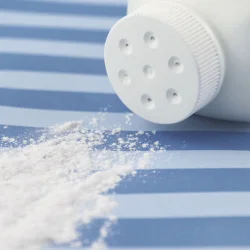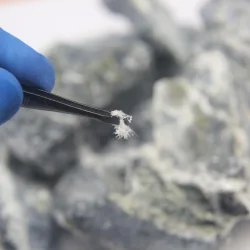Our legal team can help. Please click the button below for a Free Consultation or call us toll-free 24 hrs/day for legal advice by dialing (866) 588-0600.
At Schmidt & Clark, LLP, we are dedicated to helping individuals who have suffered due to talcum powder products. Our experienced legal team is here to guide you through the process and fight for the compensation you deserve.
Contact Schmidt & Clark, LLP today for a free, no-obligation consultation.
Table Of Contents
- Baby Powder Mesothelioma Lawsuit Overview
- Latest Baby Powder Mesothelioma Lawsuit Updates
- Baby Powder Injuries & Side Effects
- Do You Qualify for a Baby Powder Mesothelioma Lawsuit?
- Baby Powder Recall Information
- Statute of Limitations for Baby Powder Lawsuits
- FAQs
- 1. How long does it take to develop mesothelioma after exposure to asbestos in talcum powder?
- 2. Who is eligible to file a baby powder lawsuit?
- 3. What is the average settlement amount for baby powder lawsuits?
- 4. How long does a baby powder lawsuit take to resolve?
- 5. Is talc-free baby powder safe?
- 6. Can I still file a lawsuit if the talcum powder use was decades ago?
- 7. What companies are facing baby powder lawsuits?
- 8. Is baby powder safe for lungs?
- 9. What talc products may contain asbestos?
- Get a Free Baby Powder Mesothelioma Lawsuit Evaluation With Our Lawyers
- References
Baby Powder Mesothelioma Lawsuit Overview
Baby powder lawsuits center on allegations that manufacturers like Johnson & Johnson failed to warn consumers about potential asbestos contamination in their talc-based products. These cases involve claims from individuals who developed mesothelioma and other serious respiratory conditions after using these products.
According to recent studies, researchers have documented 166 instances of mesothelioma linked to substantial exposure to cosmetic talc products. The FDA has also found traces of asbestos in certain talc-based products, leading to recalls and increased regulatory scrutiny.
Latest Baby Powder Mesothelioma Lawsuit Updates
- May 16, 2025 – The FDA announced that it will host its first independent scientific expert panel on evaluating the use of talc in food, drugs, and cosmetic consumer products on May 20. The public roundtable will be led by FDA commissioner Dr. Martin Makary [1].
- January 2023 – According to the Journal of Occupational Medicine and Toxicology, researchers documented 166 instances of mesothelioma linked to substantial exposure to cosmetic talc products. Of these cases, 122 were solely attributed to cosmetic talc as the known source of asbestos exposure [2].
- May 2021 – Italian researchers conducted a review focusing on primary ovarian mesothelioma, which included a case study detailing a patient’s perineal use of talcum powder spanning from 1933 to 1980 [3].
- April 2021 – A comprehensive examination of the inhalation toxicity of talc highlighted an increase in mesothelioma and lung cancer cases among talc miners and millers. Additionally, metal-casting workers using asbestos-contaminated talc reported instances of mesothelioma and asbestosis [4].
- March 2020 – A case series was published detailing 75 patients with pleural or peritoneal mesothelioma whose sole exposure to asbestos was traced back to contaminated talcum powder [5].
- January 2020 – The Journal of Occupational and Environmental Medicine published a study featuring 33 individuals with mesothelioma, all of whom had been exclusively exposed to asbestos through the use of asbestos-contaminated talcum powder [6].
Baby Powder Injuries & Side Effects

- Mesothelioma: A rare and aggressive cancer affecting the thin layer of tissue covering internal organs, particularly in the lungs and chest cavity.
- Lung Cancer: Malignant tumors that block air passages and make breathing difficult.
- Ovarian Cancer: Cancerous growth in the ovaries linked to perineal use of talcum powder.
- Asbestosis: A chronic lung disease characterized by scarring of lung tissue, leading to shortness of breath and other respiratory issues.
If you breathe asbestos fibers, you may increase the risk of several serious diseases, including asbestosis, mesothelioma, and lung cancer.
– Minnesota Department of Health.
Do You Qualify for a Baby Powder Mesothelioma Lawsuit?

- You used talc-based baby powder products over an extended period.
- You have been diagnosed with mesothelioma, ovarian cancer, lung cancer, or other asbestos-related diseases.
- Your diagnosis occurred after using talcum powder products.
- You can provide medical documentation linking your injuries to talcum powder use.
Evidence Required for a Baby Powder Mesothelioma Lawsuit
To strengthen your case, the following evidence is typically required:
- Medical records confirming your diagnosis
- Proof of talcum powder product use (receipts, product packaging, testimony)
- Documentation of the duration and frequency of product use
- Expert testimony establishing a link between your condition and talcum powder use
Damages You Can Recover

- Medical expenses (past and future)
- Lost wages and diminished earning capacity
- Pain and suffering
- Emotional distress
- Punitive damages in cases of gross negligence
Baby Powder Recall Information

By May 2020, Johnson & Johnson announced it would discontinue selling talc-based baby powder in the United States and Canada, though the company maintained that the product was safe.
Statute of Limitations for Baby Powder Lawsuits
The statute of limitations for filing a baby powder lawsuit varies by state, typically ranging from 1-6 years from the date of diagnosis or discovery that the illness may be linked to talcum powder use. Due to the latency period of asbestos-related diseases, many states have special provisions that extend the filing deadline for these cases.
It’s crucial to consult with an attorney as soon as possible to ensure your claim is filed within the applicable timeframe.
FAQs
1. How long does it take to develop mesothelioma after exposure to asbestos in talcum powder?
Mesothelioma typically has a latency period of 20-50 years, meaning symptoms may not appear until decades after exposure to asbestos-contaminated talcum powder.
2. Who is eligible to file a baby powder lawsuit?
Anyone diagnosed with mesothelioma, ovarian cancer, or other asbestos-related diseases after using talcum powder products may be eligible to file a lawsuit. Family members may also file on behalf of deceased loved ones.
3. What is the average settlement amount for baby powder lawsuits?
Settlements in talcum powder lawsuits vary widely based on factors such as the severity of the illness, duration of product use, and strength of evidence. Some cases have resulted in multi-million dollar verdicts, such as the $27.4 million awarded to a claimant who developed mesothelioma after using Johnson & Johnson’s baby powder.
4. How long does a baby powder lawsuit take to resolve?
The timeline varies depending on case complexity, but talcum powder lawsuits typically take 1-3 years to resolve. Some cases settle quickly, while others proceed to trial.
5. Is talc-free baby powder safe?
Talc-free alternatives, such as cornstarch-based baby powders, do not carry the risk of asbestos contamination and are generally considered safer options.
6. Can I still file a lawsuit if the talcum powder use was decades ago?
Yes, due to the long latency period of asbestos-related diseases, many states have special provisions that allow filing based on when the illness was diagnosed rather than when exposure occurred.
7. What companies are facing baby powder lawsuits?
Johnson & Johnson is the primary defendant in most talcum powder lawsuits, but other manufacturers and suppliers, including Colgate-Palmolive and Imerys Talc America, have also faced litigation.
8. Is baby powder safe for lungs?
No, baby powder is not safe for the lungs. While talcum powder itself isn’t harmful, the potential presence of asbestos-contaminated talc can be. Inhalation of asbestos fibers can lead to severe pulmonary issues and diseases like mesothelioma.
9. What talc products may contain asbestos?
Products that may contain asbestos-contaminated talc include Johnson & Johnson’s baby powder, body powder, Shower to Shower, and other cosmetic and industrial talc products.
See all related product liability lawsuits our attorneys covered so far.
Get a Free Baby Powder Mesothelioma Lawsuit Evaluation With Our Lawyers

Schmidt & Clark, LLP offers:
- Free, confidential consultations to evaluate your potential claim
- No upfront costs or fees to begin your case
- Payment only if we win your case and secure compensation for you
References
- https://www.fda.gov/patients/fda-expert-panels/fda-expert-panel-talc-05202025
- https://occup-med.biomedcentral.com/articles/10.1186/s12995-023-00367-5
- https://www.ncbi.nlm.nih.gov/pmc/articles/PMC8126134/
- https://pubmed.ncbi.nlm.nih.gov/32816595/
- https://pmc.ncbi.nlm.nih.gov/articles/PMC7317550/
- https://pubmed.ncbi.nlm.nih.gov/31609780/

 Published by
Published by